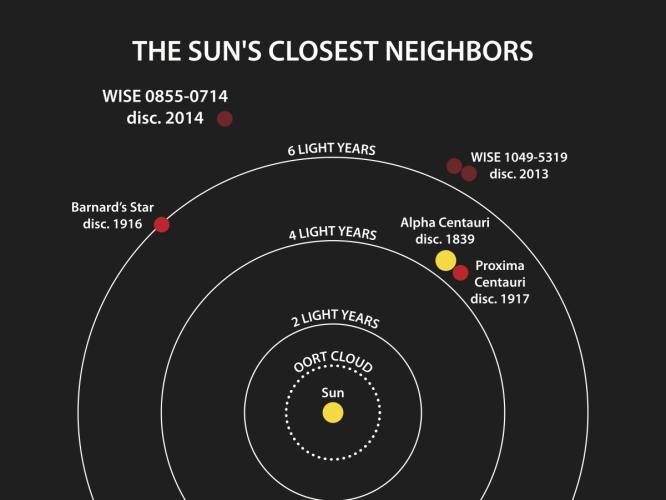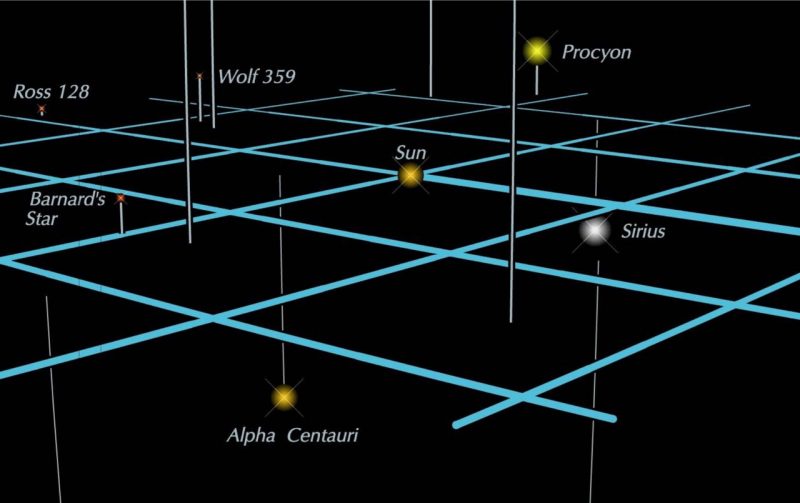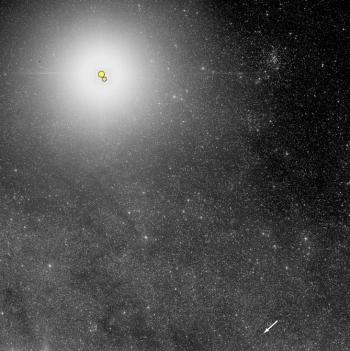Proxima Centauri is a red dwarf
The star Proxima Centauri isn’t visible to the eye. Yet it’s one of the most noted stars in the heavens. That’s because it’s part of the Alpha Centauri system, the closest star system to our sun. Alpha Centauri consists of three known stars (including Proxima). Of the three, Proxima is closest, at 4.2 light-years away. Alpha Centauri appears as the 3rd-brightest star in Earth’s sky. But Proxima is too faint to see with the eye. It’s a small, dim, low-mass star, with its own planetary system. It has two confirmed planets – and possibly a third planet – known so far. Proxima is a red dwarf star. And, like other red dwarfs, it’s also known to have massive solar flares.
Usually, when stars are so close to Earth, they appear bright in our sky. Consider the star Sirius, for example, in the constellation Canis Major. Sirius is the brightest star in Earth’s sky, at just 8.6 light-years away. So why isn’t Proxima Centauri, at 4.22 light years away, even brighter?
Far from being bright, Proxima is exceedingly dim. It shines at about +11 magnitude.
And that’s the nature of red dwarf stars like Proxima. These stars – the most common sorts of stars in our Milky Way galaxy – are too puny to shine brightly. Indeed, Proxima contains only about an eighth of the mass of our sun. Faint red Proxima Centauri is only 3,100 Kelvin (5,100 degrees F or 2,800 C) in contrast to 5,778 K for our sun.
So, in visible light, Proxima Centauri is only 0.0056% as luminous as our sun.
The 2024 lunar calendars are here! Best Christmas gifts in the universe! Check ’em out here.
Proxima’s location, seen from Earth
In Earth’s sky, Proxima is located in the direction of our constellation Centaurus the Centaur. That’s a southern constellation, best seen from Earth’s Southern Hemisphere. And indeed – although it can be glimpsed from very southerly latitudes in the Northern Hemisphere – many experience northern stargazers say they’ve never seen Alpha Centauri.
Proxima lies nearly a fifth of a light-year from Alpha Centauri A and B. Because it’s so far from the two primary stars, some scientists question whether it’s really part of the star system. As an illustration, the charts below will give you a sense of Proxima’s location with respect to our sun and other stars, and with respect to Alpha Centauri A and B.
All of these nearby stars – Proxima, Alpha Centauri A and B, and our sun – orbit together around the center of our Milky Way galaxy.
Read more: Where is Proxima Centauri?
Planets orbiting Proxima
In 2016, the European Southern Observatory (ESO) announced the discovery of Proxima b, a planet orbiting Proxima Centauri at a distance of roughly 4.7 million miles (7.5 million km) with an orbital period of approximately 11.2 Earth days. Its estimated mass is at least 1.3 times that of the Earth.
Proxima b is within the habitable zone of its star. But a 2017 study suggests that the exoplanet does not have an Earth-like atmosphere.
In June 2020, scientists announced that they had discovered a second planet around the star, Proxima c. This second planet for Proxima is a lot larger than Earth and orbits its star every 1,907 days. It orbits at about 1.5 times the distance from its star than Earth orbits from the sun.
Then in 2022, the discovery of a third planet candidate orbiting Proxima Centauri was announced. Researchers using the European Southern Observatory’s Very Large Telescope (VLT) said they found a third planet orbiting Proxima Centauri. The planet, Proxima d, is only 1/4 the mass of Earth and one of the smallest and lightest exoplanets ever discovered. It orbits close to its star, at a distance of approximately 4 million kilometers (2.5 million miles). And it completes one orbit in only five days.
By the way, any planets around Proxima Centauri would contend with massive flares that pop off the red dwarf, which might or might not spell doom.
Record-breaking flare on Proxima Centauri
Astronomers said in April 2021 that they spotted a flare – or burst of radiation – from Proxima that’s 100 times more powerful than any flare seen from our sun. They said the flare ranks as one of the most violent seen on a solitary star anywhere in the galaxy. Flares like this on Proxima could doom chances for life on its planets.
Astronomer R. O. Parke Loyd of Arizona State University said the verdict for life could go either way. On the one hand, the flares will eventually decimate a planet’s atmosphere. But on the other hand, flares could spark life.
In fact, Proxima Centauri appears to have frequent flares. According to NASA:
The star known as Proxima Centauri, the sun’s nearest interstellar neighbor, turns out to have a hair-trigger temper, frequently erupting with potentially damaging stellar flares, including its largest ever recorded.
A signal from our nearest neighbor?
Many scientists engaged in the Search for Extraterrestrial Intelligence (SETI) consider the famous Wow! signal to be the best known candidate for an alien radio signal. The 1977 Wow! signal was heard only once. It was never fully confirmed and remains unexplained to this day. But in 2020 scientists found a new possible signal, dubbed by some as Wow! signal 2020. And it appeared to come from our nearest neighbor, Proxima Centauri.
However, it turned out to be from another planet, our own Earth. The source was eventually pinpointed to originate from somewhere in Australia.
Bottom line: Proxima Centauri is the nearest star to our sun at 4.22 light-years away. It’s home to at least 2 planets and has massive solar flares.
Enjoying EarthSky so far? Sign up for our free daily newsletter today!
















